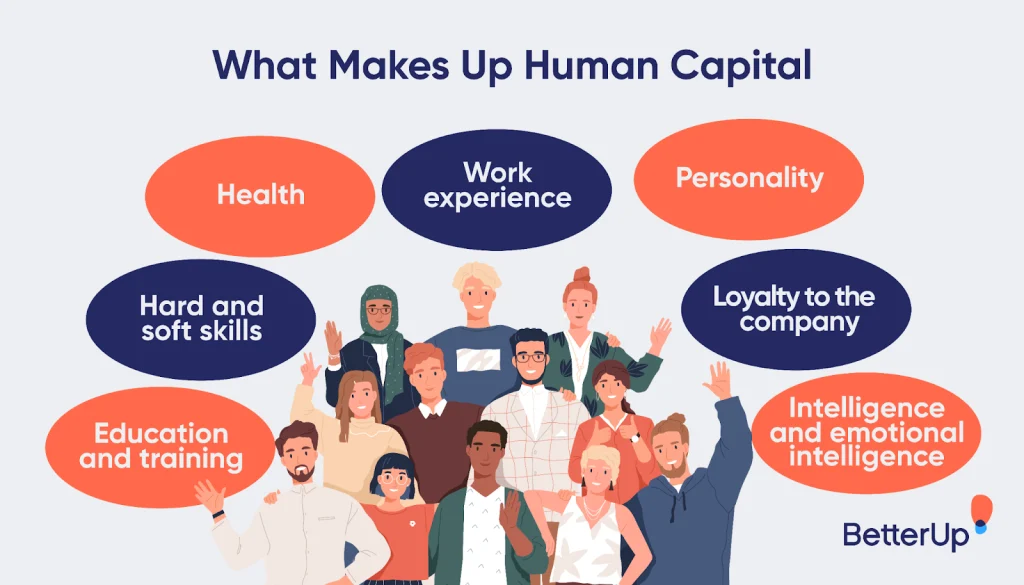Human capital refers to the skills, knowledge, and experience possessed by individuals, which is essential for economic productivity and growth. In the U.S., education, training, and workforce development are crucial components for building and enhancing human capital. This article explores the state of human capital in the U.S., focusing on educational attainment, vocational training, workforce development programs, and policy implications.
Education in the U.S.
K-12 Education
- Overview: The K-12 education system in the U.S. serves as the foundation for human capital development. It includes elementary, middle, and high school education.
- Challenges: The U.S. faces significant disparities in education quality and outcomes across different regions and demographic groups. Issues such as funding inequality, access to resources, and varying academic standards contribute to these disparities.
- Reforms and Initiatives: Efforts to improve K-12 education include the implementation of Common Core standards, increased focus on STEM (Science, Technology, Engineering, and Mathematics) education, and expanding access to early childhood education programs.
Higher Education
- Institutions: The U.S. boasts a diverse range of higher education institutions, including community colleges, public and private universities, and technical schools.
- Access and Affordability: Rising tuition costs and student debt are major concerns. Efforts to address these issues include increasing financial aid, implementing tuition-free community college programs, and exploring income-driven repayment plans for student loans.
- Outcomes: Higher education is associated with higher earning potential and lower unemployment rates. However, there is a need to align educational programs with labor market demands to ensure graduates have relevant skills.
Training and Vocational Education
Vocational and Technical Training
- Importance: Vocational and technical training programs provide individuals with specific skills required for various trades and industries, playing a critical role in workforce development.
- Programs: These include apprenticeship programs, trade schools, and certification courses in fields such as healthcare, information technology, manufacturing, and construction.
- Benefits: Vocational training offers a pathway to well-paying jobs without the need for a four-year college degree. It also helps meet the demand for skilled labor in various sectors.
Workforce Development Programs
- Government Initiatives: The U.S. Department of Labor and other federal and state agencies offer various programs to support workforce development. Examples include the Workforce Innovation and Opportunity Act (WIOA), which provides funding for job training and employment services.
- Private Sector Involvement: Many companies invest in employee training and development programs to enhance skills and retain talent. Partnerships between businesses and educational institutions are also growing, aiming to create curricula that match industry needs.
Workforce Development Challenges
Skills Gap
- Definition: The skills gap refers to the mismatch between the skills employers seek and the skills available in the labor force.
- Impact: This gap can lead to unfilled job vacancies and hinder economic growth. Sectors like technology, healthcare, and advanced manufacturing are particularly affected.
- Solutions: Addressing the skills gap involves enhancing career and technical education, promoting lifelong learning, and fostering collaboration between employers and educators to align training programs with market needs.
Technological Advancements
- Automation and AI: Technological advancements are transforming the labor market, leading to both the creation of new job opportunities and the displacement of certain jobs.
- Reskilling and Upskilling: Workers must adapt to these changes through reskilling (learning new skills for a different job) and upskilling (enhancing current skills to stay competitive in their field). Programs focused on digital literacy and advanced technical skills are essential.
Workforce Diversity and Inclusion
- Importance: A diverse and inclusive workforce can drive innovation and productivity. Ensuring equal opportunities for all demographic groups is crucial for maximizing human capital.
- Efforts: Initiatives to promote diversity and inclusion include targeted recruitment, mentorship programs, and policies that support work-life balance and equitable career advancement.
Policy Implications and Recommendations
Investment in Education
- Funding: Increased investment in K-12 and higher education is necessary to address disparities and ensure all students have access to quality education.
- Innovative Programs: Supporting programs that integrate academic learning with practical experience, such as internships and co-op programs, can enhance student readiness for the workforce.
Support for Vocational Training
- Expansion: Expanding access to vocational training and apprenticeship programs can provide viable career paths for individuals and meet the demand for skilled labor.
- Public-Private Partnerships: Encouraging collaboration between educational institutions, employers, and government agencies can help create training programs that align with industry needs.
Addressing the Skills Gap
- Lifelong Learning: Promoting lifelong learning and continuous skill development is essential in a rapidly changing job market. This includes support for adult education and training programs.
- Alignment with Industry Needs: Ensuring that educational and training programs are aligned with current and future labor market demands can help reduce the skills gap and improve employment outcomes.
Promoting Workforce Diversity
- Inclusive Policies: Implementing policies that promote diversity, equity, and inclusion in the workplace can enhance human capital development and economic productivity.
- Supportive Environments: Creating supportive work environments that value diverse perspectives and provide equal opportunities for advancement is crucial for a thriving workforce.
Conclusion
Human capital development through education, training, and workforce development is vital for the U.S. economy. Addressing challenges such as the skills gap, technological advancements, and workforce diversity requires coordinated efforts from government, educational institutions, and the private sector. By investing in human capital, the U.S. can ensure a competitive, innovative, and inclusive workforce for the future.
